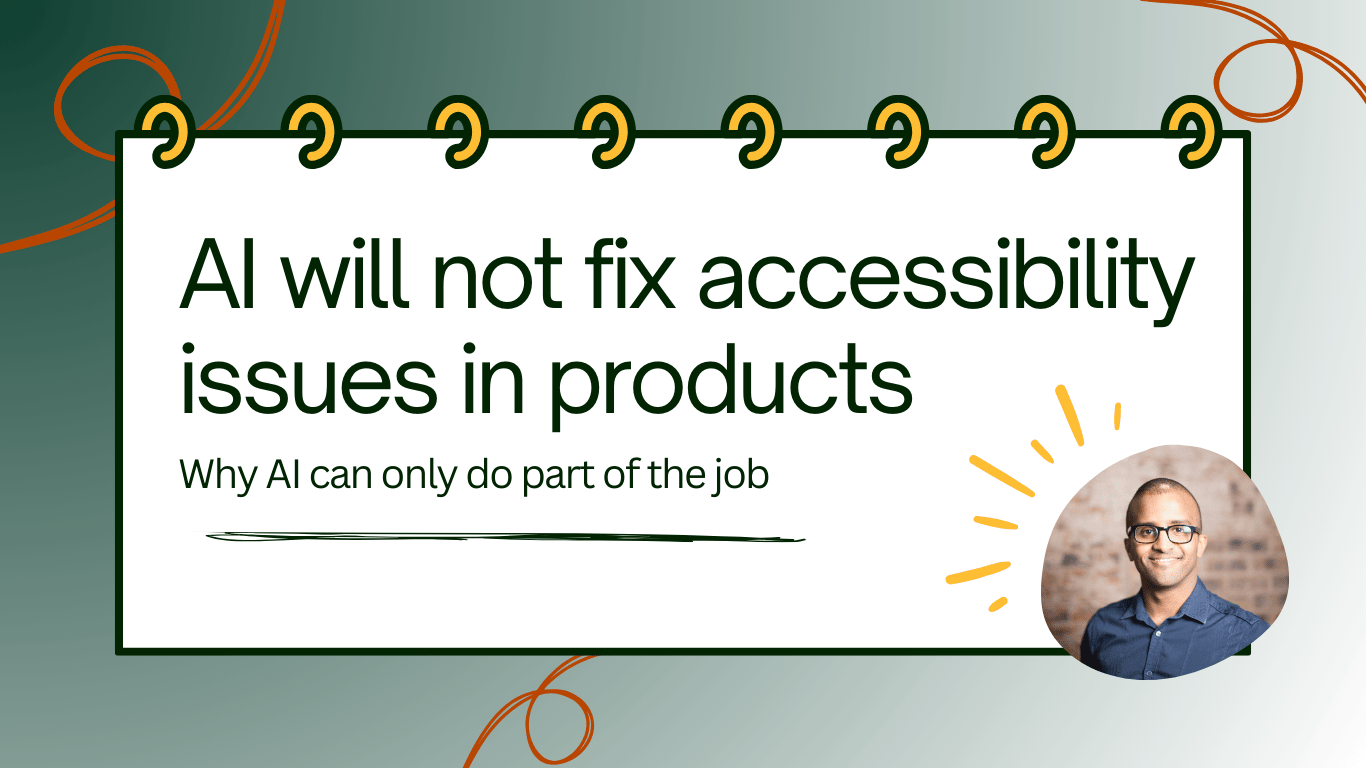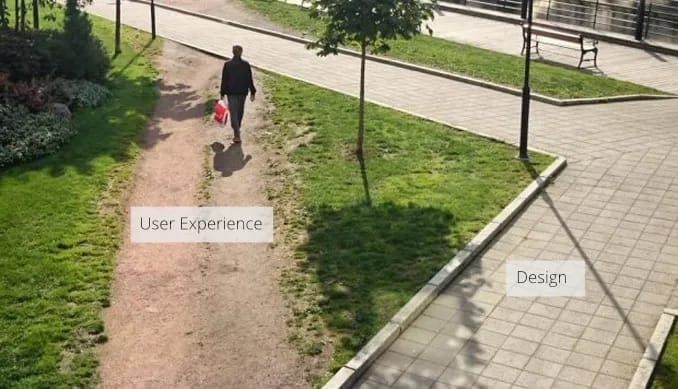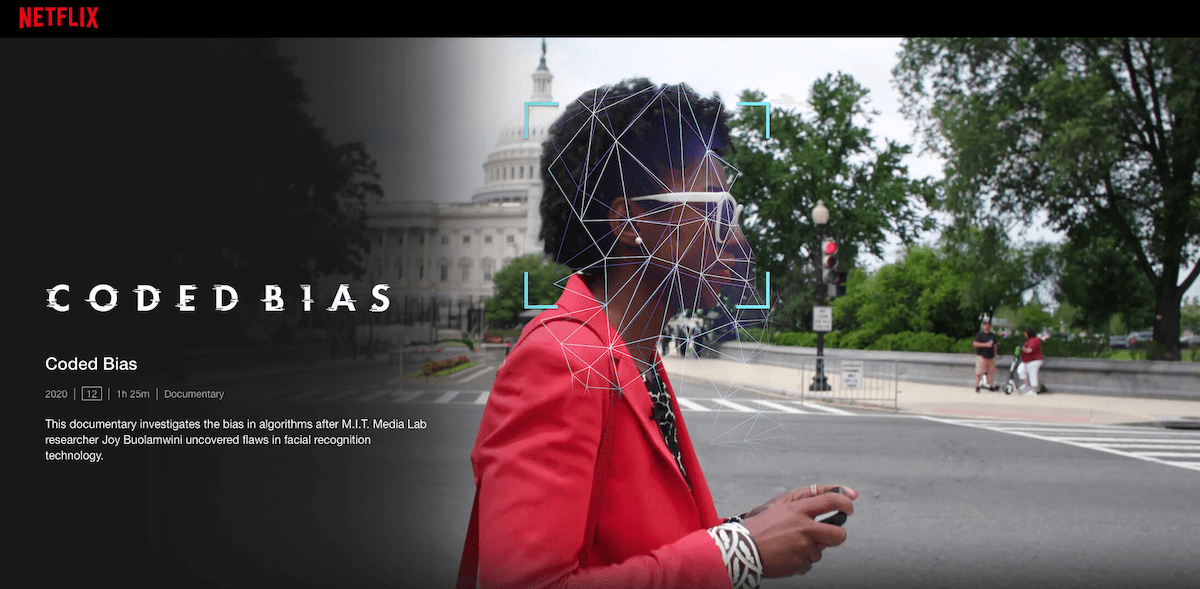AI will not fix accessibility issues in products
It seems like not a day goes by without some kind of groundbreaking new development in Generative AI. But regardless of this, it will not fix accessibility issues in products.

It's been a long time since a trend in our tech-focused society has overhauled how the entire internet works; so much so that it became a hot topic for all brands and individuals. But that is the impact of what Generative Artificial Intelligence (AI) is having on all of us.
I'm getting the sense that every product is now promoting AI as their main feature and benefit, promising you that it will change your life and how you work forever. Bold statement. I'm not sure if that's the right approach, but that's another story. What is definitely happening is that people are throwing the word "AI" to make something accessible. This doesn't make sense since accessibility is a human challenge that requires human inputs and human context.
And as realistic as they are at this early stage, AI is not human.
Sure, AI is becoming more and more human-like everyday. But that's like saying virtual relationships and video calls are better than face-to-face. It's not and we know that. It's just a powerful tool that provides us another way of communicating. But it removes some of that human elements that only exists in an in-person relationship, which is what we humans constantly craves for.
Below are some of the reasons why I believe AI won't fix accessibility.
Why AI won't fix accessibility [TL;DR]
- Lack of human touch and empathy
- The complexity of individual human needs
- AI output is based on user input
- AI out is based on database input
- Most design and code are not accessible
- Accessibility are not often not taught to beginners
- Dependency on proper implementation
- Limited universal standards
- Concerns over bias and fairness in AI algorithms
- Privacy, ethical and security risks
- Systemic issues within socio-economical factors and policies
- Built environment accessibility has its own complexity needs
1. Lack of human touch and empathy
You can't talk about accessibility without understanding that there are real people behind the screens with real barriers in front of them i.e. your inaccessible products.
Much like when doing customer research and focus groups, it's crucial to understand the individual customers' pain points and implement a solution. Without that, no product will be a success. It's only when you truly understand their barriers, difficulties and ideas that you'll be able to:
1. understand and empathise with real human
2. have a real solution that you could use and to get them tested out by real people too.

This is also a huge reasons why the use of accessibility overlays (and their heavily marketed and deceptive claims about using their tools to fix accessibility) is not a solution. And they are also guilty of claiming that you can magically fix accessibility with their AI-generated features.
The irony...
You can learn more about accessibility overlays and the problems they cause here.
^ Back to top2. The complexity of individual human needs
It doesn't matter if you have accessibility needs or not, you will have your own unique requirements when facing a challenge, using a product and living your day-to-day life. So how one customer uses a product is very different to how another would use it, regardless of how much you try to enforce it.

But if we put our accessibility mindset switched on, this is incredibly important to take into account when dealing with complex topics like disability. What works for one deaf person will not necessarily apply to everyone.
And like the 'campus meme' image above, just because you have implemented something that you think is a solution, it doesn't mean it will be used how you envisioned it. But if you consider how complex humans can be, a human touch is almost certainly the solution.
^ Back to top3. AI output is based on user input
When experimenting with various AI tools, I've learnt (the hard way) that there is somewhat of an art and skill into writing prompts. For example, consider the difference the following two prompts:
- What are the best things to do in Edinburgh?
- You are a tour guide, specialising in the city of Edinburgh and knows all the best places to visit that are, not just for tourists, but also the hidden gems that are known to the locals only. I am visiting the city for 3 full days with my spouse and two children aged 13 and 15. Can you provide me with a list of things to do that is appropriate for all of us, which also include places to eat along the way, organised in a day-by-day itinerary?
It's no question that the second answer will yield a much better quality result by a huge margin (try it yourself in your AI tool of choice). But that requires practice but also patience to write it all out, plus adjusting and optimising the original prompts plus asking follow-up questions. And who is to say that I've written it correctly or if there's one way of doing it.
There isn't, and that will apply to accessibility-related prompts too.
We can't expect everyone to do the same for accessibility related solutions. There are far too many nuances and elements to consider that will impact the output. At the same time, the other points below will severely affect the quality of the results too.
^ Back to top4. AI output is based on machine learning input
Since the output is also dependent on machine learning and using data that is freely available online to give you answers, that should also be a warning sign.
The internet, as it will be demonstrated in the next point, exhibits strong characteristics of ableism since the majority of the content are inaccessible.
And with many data about accessibility outdated, ill-advised, incorrect, lacking context or even not checked, there is a danger of users freely accepting whatever advice AI has provided...lack installing accessibility overlays.
^ Back to top5. Most design and code are not accessible

Since 2019, the WebAIM Million is updated on a yearly basis to demonstrate how accessible are the top 1,000,000 homepages and to:
"provide an overview of and insight into the current state of web accessibility for individuals with disabilities as well as trends over time".
It's a fascinating study but also sad one because the number of errors and issues found are incredibly high and it doesn't seem to be getting better.
That alone tells you the state of the internet. And if AI tools are using those database as their benchmark on what is accessible, then already, we are starting on the wrong foot.
^ Back to top6. Accessibility are often not taught to beginners
Part of the reasons why many of the design and code are not accessible is because they are often not taught to beginners.
But it's not just beginners too. Many experienced developers are also guilty of implementing inaccessible solutions. This could be because of lack of knowledge, the desire to find quick solutions...who knows?!
I have been in workplaces where experienced front-end developers have deliberately made use of heading tags like H1, H2, H3, etc. for styling purposes rather than for creating structure and hierarchy in a page (which will have benefits for both accessibility and SEO).
I have also seen online web development courses where it brushes over accessibility or at the very most, touches on it lightly on the topic.
The fact that most codes and developers are not approaching products with accessibility, this will mean AI algorithm will be full of non-accessible coding bias.
^ Back to top7. Dependency on proper implementation
Let's just say, hypothetically speaking, you actually managed to find an accurate solution where an AI tool has provided the correct code to implement, there is a lot of dependency on making sure that you are implementing it correctly.
What, you're going to ask an AI chatbot where to implement it? With so many nuances and the need to understand the purpose of the product, who is the target market, the goal of that product, etc., it could get even messier if these tools are going to implement it without full understanding of the company you are representing.
8. Limited universal standards

Like anything online, there isn't a set standard for how to create anything. There isn't one way of creating a website, app, software. There are standards and best practices, but definitely not one way of doing it.
It's also not possible to make something 100% complete. For example, it is impossible for SEO to be 100% done. Literally impossible. Again, there are best practices and guidelines to follow, but not to complete it.
The same applies in accessibility; there isn't one way of doing things nor is there a way to be "100% accessible". Just like there's no such thing as becoming "100% SEO-friendly".
Sure there is there are guidelines like the W3C Accessibility Standards Overview. But even that is a guideline (a very good one, but still a guideline) rather than the complete checklist to make you fully accessible...whatever that means.
That makes it complicated if a person is using AI to fix accessibility because there will most likely be a checklist of some sort that is gamified and will guide you to tick all the boxes. This will create a false impression that you are "done".
But it's impossible to be done in accessibility. It's a constant state of evolution when humans uses technology; it changes every day.
^ Back to top9. Concerns over bias and fairness in AI algorithms
It's no secret that generative AI tools are using machine learning process and gather huge amount of data from the internet. And if the majority of the internet consists of inaccessible code, how do you think this will affect the accuracy of the output that has been executed by the AI algorithms?
This is a common issue that exists in the tech world today. I remember watching a Netflix documentary called 'Coded Bias'. It follows M.I.T. Media Lab researcher Joy Buolamwini who has uncovered flaws in facial recognition technology (think racist profiling), the real-life impacts that they are having (think scoring system that determines who gets housing, loans, etc.) and how it is prevalent in the systems that are created today because of how they are mainly created by a cast of mostly-male and mostly-white engineers.

This was before all the huge hype about AI that we are seeing today. But even in the most recent cases (as of May 2024), Meta's new AI council consists of mainly white men in it:
"It’s telling that the AI advisory council is composed entirely of businesspeople and entrepreneurs, not ethicists or anyone with an academic or deep research background." - TechCrunch
Anyway, I highly recommend you watch the Netflix documentary. Even if you are not a techy person, it's still a very digestible and captivating.
^ Back to top10. Privacy, ethical and security risks
It's one thing to talk about the biased algorithm that exists today, it's another when you are touching on the subject that can be very personal and highly sensitive for many people; disability, medical, accessibility requirements.
There is risk of data breaches or misuse of information. Is it worth the risk?
^ Back to top11. Systemic issues within socio-economical factors and policies
This is touched upon briefly early about bias codes, but it's impossible to ignore the systemic issues that exists online and offline which have created those barriers in the first place.
Accessibility is also influenced by socio-economic factors and local/national policies, such as education, employment opportunities, and policy frameworks. AI alone cannot address these broader systemic issues which have created the barriers in the first place, both online and offline.
I'm not saying you should focus your attention on influencing those factors. But having that awareness is important as it will further enforce that there are bigger reasons accessibility exists in the first place, and there's nothing AI can do to change that. As we have noticed before, it will require humans to have any kind of impacts.
^ Back to top12. Built environment accessibility has its own complexity needs

I'm familiar with the use of AI and augmented reality in scenarios such as interior decorating and implementing infrastructure where they are created to make an experience a smooth one for e.g. visitors attending entering a museum.
But let's face it, physical accessibility is also a complex topic. You can't honestly assume that the requirement of one partially-sighted person who is navigating through a newly built art gallery will be the same for everyone who is blind or partially-sighted.
Of course not.
^ Back to topWhen can AI help accessibility?
This post might give you the impression that AI can't help with accessibility. But that's not the case, as there are plenty of very innovative companies and technologies that uses AI in a manner that actually helps individual humans.
For example:
- Auto-generated captions (but you still need to edit them to make readable and accurate)
- Live transcription that runs through a virtual meeting that could then be exported
- Be My Eyes - an app that helps blind and low-vision users who want sighted assistance with volunteers. But recent advancement in AI meant that it can help to provide assistance too.
- Speechify - an AI-based text to speech reader
I'm hoping that you are spotting a theme here. But if you haven't, you may have noticed how much I have emphasised on the word 'human' on this page alone.
But this wasn't a deliberate ploy by me to ram it into your head. It just so happens to be that humans are best
You can use AI to help part of the way though. Auto-caption is one excellent example of that. It's not a solution as they will require editing (like any auto-generated content), but it provided a stepping stone into making videos accessible before, you guessed it, a human takes over to check and make the necessary editing.
The end result will almost always require humans to be involved in all stages of the journey. And I think we can all agree that this applies to every single projects that we as humans are creating.
Don't you think?
